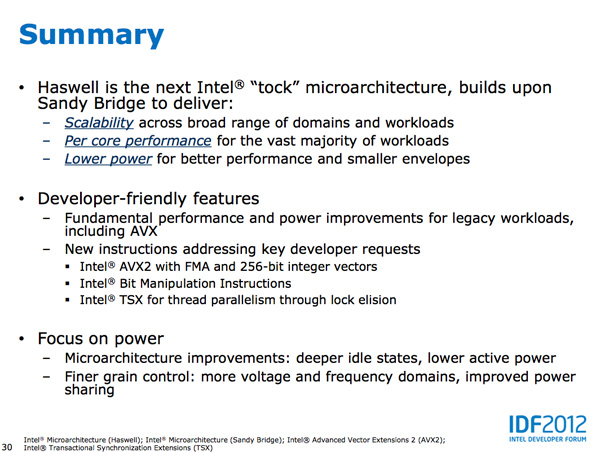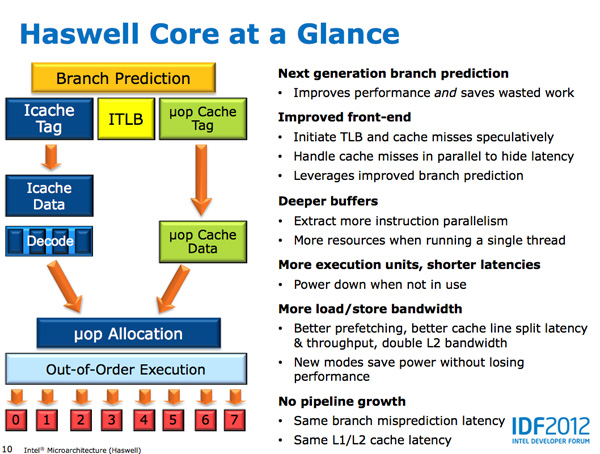Intel's Haswell Architecture Analyzed: Building a New PC and a New Intel
by Anand Lal Shimpi on October 5, 2012 2:45 AM ESTFinal Words
After the show many seemed to feel like Intel short changed us at this year's IDF when it came to architecture details and disclosures. The problem is perspective. Shortly after I returned home from the show I heard an interesting comparison: Intel detailed quite a bit about an architecture that wouldn't be shipping for another 9 months, while Apple wouldn't say a thing about an SoC that was shipping in a week. That's probably an extreme comparison given that Apple has no motivation to share details about A6 (yet), but even if you compare Intel's openness at IDF to the rest of the chip makers we cover - there's a striking contrast. We'll always want more from Intel at IDF, but I do hope that we won't see a retreat as the rest of the industry seems to be ok with non-disclosure as standard practice.
There are three conclusions that have to be made when it comes to Haswell: its CPU architecture, its platform architecture and what it means for Intel's future. Two of the three look good from my perspective. The third one is not so clear.
Intel's execution has been relentless since 2006. That's over half a decade of iterating architectures, as promised, roughly once a year. Little, big, little, big, process, architecture, process, architecture, over and over again. It's a combination of great execution on the architecture side combined with great enabling by Intel's manufacturing group. Haswell will continue to carry the torch in this regard.
The Haswell micro-architecture focuses primarily on widening the execution engine that has been with us, moderately changed, for the past several years. Increasing data structures and buffers inside the processor helps to feed the beast, as does a tremendous increase in cache bandwidth. Support for new instructions in AVX2 via Intel's TSX should also pave the way for some big performance gains going forward. Power consumption is also a serious target for Haswell given that it must improve performance without dramatically increasing TDP. There will be slight TDP increases across the board for traditional form factors, while ultra portables will obviously shift to lower TDPs. Idle power drops while active power should obviously be higher than Ivy Bridge.
You can expect CPU performance to increase by around 5 - 15% at the same clock speed as Ivy Bridge. Graphics performance will see a far larger boost (at least in the high-end GT3 configuration) of up to 2x vs. Intel's HD 4000 in a standard voltage/TDP system. GPU performance in Ultrabooks will increase by up to 30% over HD 4000.
As a desktop or notebook microprocessor, Haswell looks very good. The architecture remains focused and delivers a sensible set of improvements over its predecessor.
As a platform, Haswell looks awesome. While the standard Haswell parts won't drive platform power down considerably, the new Haswell U/ULT parts will. Intel is promising a greater than 20x reduction in platform idle power and it's planning on delivering it by focusing its power reduction efforts beyond Intel manufactured components. Haswell Ultrabooks and tablets will have Intel's influence in many (most?) of the components placed on the motherboard. And honestly, this is something Intel (or one of its OEMs) should have done long ago. Driving down platform power is a problem that extends beyond the CPU or chipset, and it's one that requires a holistic solution. With Haswell, Intel appears committed to delivering that solution. It's not for purely altruistic reasons, but for the survival of the PC. I remember talking to Vivek about an iPad as a notebook replacement piece he was doing a while back. The biggest advantage the iPad offered over a notebook in his eyes? Battery life. Even for light workloads today's most power efficient ultraportable notebooks can't touch a good ARM based tablet. Haswell U/ULT's significant reduction in platform power is intended to fix that. I don't know that we'll get to 10+ hours of battery life on a single charge, but we should be much better off than we are today.
Connected standby is coming to PCs and it's a truly necessary addition. Haswell's support of active idle states (S0ix) is a game changer for the way portable PCs work. The bigger concern is whether or not the OEMs and ISVs will do their best to really take advantage of what Haswell offers. I know one will, but will the rest? Intel's increasingly hands on approach to OEM relations seems to be its way of ensuring we'll see Haswell live up to its potential.
Haswell, on paper, appears to do everything Intel needs to evolve the mobile PC platform. What's unclear is how far down the TDP stack Intel will be able to take the architecture. Intel seems to believe that TDPs below 8W are attainable, but it's too early to tell just how low Haswell can go. It's more than likely that Intel knows and just doesn't want to share at this point. I don't believe we'll see fanless Haswell designs, but Broadwell is another story entirely.
There's no diagram for where we go from here. Intel originally claimed that Atom would service an expanded range of TDPs all the way up to 10W. With Core architectures dipping below 10W, I do wonder if that slide was a bit of misdirection. I wonder if, instead, the real goal is to drive Core well into Atom territory. If Intel wants to solve its ARM problem, that would appear to be a very good solution.












245 Comments
View All Comments
A5 - Friday, October 5, 2012 - link
8 years is a loooooong time in this space, and yes you (and most people here) are in the minority.Notebooks have been outselling desktops for several years, and in 2011 smartphone shipments were higher than all PC form-factors combined. It's pretty clear where the big bucks are going, and it isn't desktop PCs.
flamethrower - Friday, October 5, 2012 - link
In 8 years you'll have 50-inch OLED TVs on your walls. What's going to drive them? Possibly a computer integrated into them.Peanutsrevenge - Friday, October 5, 2012 - link
We'll just be using large screens, keyboards and mice wireless connected to our ultra portable devices.The desktop will likely still exist for people like us who frequent this site, however it's role will be far more specialised, possibly more as our personal cloud servers than our PCs.
yankeeDDL - Friday, October 5, 2012 - link
Wow. Thanks for the excellent article: I really enjoyed it.The thought of having a processor of the power level of Ivy bridge in my mobile phone blows my mind.
Honestly though, I really can't see how the volume of CPUs for desktop PCs and servers is going to drop so dramatically, that Intel will need the volume generated by mobile, to "survive".
Yes, of course more volume will help, but 8 years from now, even if the mobiles will have such kind of computational power, I would imagine that a Desktop would have 10~20x that performance, as it is today.
It's true that today's CPUs are typically more powerful than the average user ever needs, but raise the hand who wouldn't trade his CPU for one 10x faster (in the same power envelope) ...
That said, 10W still seems like a lot to fit in a mobile: who knows the power consumption of high-end mobile CPUs today? (quad-core Krait CPU, for example, or even Tegra3)
dagamer34 - Friday, October 5, 2012 - link
Intel's real problem is that the power needed for "good enough" computing in a typical desktop CPU came a couple of years ago Nd is rapidly approaching in mobile. With more and more tasks being offloaded to the cloud, battery life is becoming a stronger and stronger focus.What's sad is that because AMD isn't the major player it once was, Intel has allowed it's eye off the ball, revving Atom with only minor tweaks and having a laissez faire approach to GPU performance. It's only been recently when mobile has started to dominate in the minds of consumers and Intel's lack of any major design wins (the RAZR I doesn't count) which has forced Intel to push as hard as it is now.
sp3x0ps - Friday, October 5, 2012 - link
Where is the iPhone 5 review? I need details!! arghh.Demon-Xanth - Friday, October 5, 2012 - link
Atom was targeted to UMPCs, but quickly took over low power embedded systems who don't need much power but do run Windows.tipoo - Friday, October 5, 2012 - link
Poor Via.dgingeri - Friday, October 5, 2012 - link
"Within 8 years many expect all mainstream computing to move to smartphones, or whatever other ultra portable form factor computing device we're carrying around at that point."They said the same thing about laptops. Sure, laptops hold about 60-65% of the market these days, but the desktop is still very much around, and is the preferred platform for PC gamers and HTPC applications. They're far more flexible than any mobile form factor.
Smartphones also have the severe disadvantage of a very small screen. Even the largest are too small for most people to deal with. On top of that, actually surfing the net on those tiny screens is an exercise in frustration for many people. I try to tap on a link, only to get the link next to it, or above it, or below it, or possibly having my stupid phone just select the text instead of following the link.
Smartphones have their niche. There's no doubt there, but they are not going to be anyone's mainstream device unless they have needle thin fingers and 20/10 vision.
Anand Lal Shimpi - Friday, October 5, 2012 - link
I agree with the notebook/desktop comparison - these form factors won't go away. I should have said the majority of mainstream client computing goes to smartphones. And solving the display and input problems is easy: wireless display (WiDi/Miracast) and wireless keyboard/mouse (or a dock that does both over wires if you'd rather that).Take care,
Anand